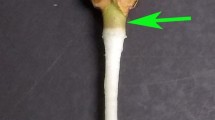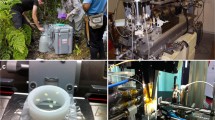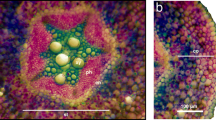Abstract
The ultrastructural investigation of the root cells ofAllium cepa L. exposed to two different concentrations of chromium + nickel (Cr+Ni) (10 μmol/L and 100 μmol/L) revealed that toxic symptoms were induced by increasing heavy metal concentration and treatment time. Several significant ultrastructural changes were caused by 100 μmol/L Cr+Ni – deposition of electron dense material in cell walls; larger vacuolar precipitates surrounded by membranes inside vacuoles; increment of disintegrated organelles and high vacuolization in cytoplasm. The localization of the precipitates in which the metal ions were detected by electron energy loss spectroscopy (EELS) and electron spectroscopic imaging (ESI) was investigated. Chromium and nickel were localized in the electron dense precipitates of the root cells exposed to only 100 μmol/L Cr+Ni. None were found in the root cells exposed to 10 μmol/L Cr+Ni. Higher amounts of Cr+Ni were mainly accumulated in the cell walls and vacuoles of the fourth or fifth cortical layer.
Similar content being viewed by others
References
Aoyama M, Tsuda M, Seki K, Doi S. Kurimoto Y, Tamura Y. Adsorption of Cr(VI) from dichromate solutions onto black locust leaves. Holzforschung. 2000;54:340–2.
Barceló J, Poschenrieder C. Chromium in plants. In: Canali, S, Tittarelli, F, Sequi, P. (eds), Chromium environmental issues. Franco Angeli Publ: Milano; 1997:101–29.
Bourque G, Vittorio P, Weinberg P. Uptake of 51Cr as an indicator of metabolic change in wheat root tips. Can J Physiol Pharmacol. 1967;45:235–9.
Bücking H, Beckmann S, Heyser W, Kottke I. Elemental contents in vacuolar granules of ectomycorrhizal fungi measured by EELS and EDXS. A comparison of different methods and preparation techniques. Micron. 1998;29:53–61.
Caridad-Cancela R, Abreu CA, Paz-González A. Total trace element contents in natural soil by two methods. Symposium no. 8, paper No. 1031, 17th World Congress of Soil Science, 14–21 August 2002, Thailand.
Cobbett CS. Phytochelatins and their roles in heavy metal detoxification. Plant Physiol. 2000;123:825–32.
Dixon NE, Gazzola C, Blakeley RL, Zerner B. Jack bean urease (E.C.3.5.1.5.) a metalloenzyme. A simple biological role for nickel? J Am Chem Soc. 1975;97:4131–3.
Guo YL, Schulz R, Marschner H. Uptake, distribution and binding of cadmium and nickel in different plant species. J Plant Nutr. 1995;18:2691–706.
Helmke PA. Soil chemistry: the chemical composition of soils. In: ME Sumner (ed), Handbook of soil science. CRC Press: Boca Raton, FL; 2000:B16–17.
Huffman EWD, Allaway WH. Growth of plants in solution culture containing low levels of chromium. Plant Physiol. 1973;52:72–5.
Irmer U, Wachholz I, Schäfer H, Lorch DW. Influence of lead on Chlamydomonas reinhardtii Danegard (Volvocales, Chlorophyta): accumulation, toxicity and ultrastructural changes. Environ Exp Bot. 1986;26:97–105.
Kabata-Pendias A, Pendias H. Trace elements in soils and plants. CRC Press: Boca Raton, FL; 2001:413.
Krämer U, Pickering IJ, Prince RC, Raskin I, Salt DE. Subcelluar localization and speciation of nickel in hyper-accumulator and non-accumulator Thlaspi species. Plant Physiol. 2000;122:1343–53.
Kukkola E, Rautio P, Huttunen S. Stress indications in copper-and nickel-exposed Scots pine seedlings. Environ Exp Bot. 2000;43:197–210.
Levan A. Cytological reactions induced by inorganic salt solutions. Nature. 1945;156:751.
Liu DH, Jiang WS, Li MS. Effects of trivalent and hexavalent chromium on root growth and cell division of Allium cepa. Hereditas. 1992;117:23–9.
Liu DH, Jiang WS, Guo L, Hao YQ, Lu C, Zhao FM. Effects of nickel sulfate on root growth and nucleoli in root tip cells of Allium cepa. Isr J Plant Sci. 1994;42:143–8.
Mertz W. Biological role of chromium. Fed Proc. 1967;26:186–93.
Myttenaere C, Mousny JM. The distribution of chromium-51 in lowland rice in relation to the chemical form and the amount of stable chromium in the nutrient solution. Plant Soil. 1974;41:65–72.
Nassiri Y, Mansot JL, Wéry J, Ginsburger-Vogel T, Amiard JC. Ultrastructural and electron energy loss spectroscopy studies of sequestration mechanisms of Cd and Cu in the marine diatom Skeletonema costatum. Arch Environ Toxicol. 1997;33:147–55.
Rauser WE, Ackerley CA. Localization of cadmium in granules within differentiating and mature root cells. Can J Bot. 1986;65:643–6.
Rauser WE. Phytochelatins and related peptides. Structure, biosynthesis, and function. Plant Physiol. 1995;109:1141–9.
Ryan CA, Walker-Simmons M. Plant vacuoles. Meth Enzymol. 1983;96:580–9.
Sanità di Toppi L, Gabbrielli R. Response to cadmium in higher plants. Environ Expt Bot. 1999;41:105–30.
Schlösser L. Einsatz von Aldehydkarbonsäure in der Chromgerbung. In: Cot J (ed), Compendium of advanced topics on leather technology, vol 2. Associación Quimica Española de la Industria del Cuero, Barcelona, 991:1017–26.
Sresty TVS, Madhava Rao KV. Ultrastructural alterations in response to zinc and nickel stress in the root cells of pigeonpea. Environ Expt Bot. 1999;41:3–13.
Srivastava S, Prakash S, Srivastava MM. Studies on mobilization of chromium with reference to its plant availability -- role of organic acids. BioMetals. 1999;12:201–7.
Spurr AR. A low-viscosity epoxy resin embedding medium for electron microscopy. J Ultrastruct Res. 1969;26:31-43.
Stephan UW, Prochazka Z, Physiological disorders of the nicotianamine-auxotroph tomato mutant chloronerva at different levels of iron nutrition. I. Growth characteristics and physiological abnormalities as related to iron and nicotianamine supply. Acta Bot Neerl. 1989;38:147–53.
Vázquez MD, Poschenrieder Ch, Barceló J. Chromium VI induced structural and ultrastructural changes in bush bean plants (Phaseolus vulgaris L.). Ann Bot. 1987;59:427–38.
Woolhouse HW. Toxicity and tolerance in the responses of plants to metals. In: Lange OL, Nobel PS, Osmond CB, Ziegler H (eds), Physiological plant ecology. III. Responses to the chemical biological environment, Springer-Verlag: Berlin; 1983:246–300.
Yang X, Baligar VC, Martens DC, Clark RB. Plant tolerance to nickel toxicity I. Influx, transport, and accumulation of nickel in four species. J Plant Nutr. 1996;19:73–85.
Yang XE, Baligar VC, Foster JC, Martens DC. Accumulation and transport of nickel in relation to organic acid in ryegrass and maize growth with different nickel levels. Plant Soil. 1997;196:271–276.
Zheng ZQ, Feng WH, Bian SP, Zheng JM, Zhang LZ, Xing SL. Study on fate of pollutant chromium in the agro-ecosystem. J Environ Sci. 1987;8:14–19.
Author information
Authors and Affiliations
Rights and permissions
About this article
Cite this article
Liu, D., Kottke, I. Subcellular localization of chromium and nickel in root cells of Allium cepa by EELS and ESI. Cell Biol Toxicol 19, 299–311 (2003). https://doi.org/10.1023/B:CBTO.0000004984.87619.15
Issue Date:
DOI: https://doi.org/10.1023/B:CBTO.0000004984.87619.15




